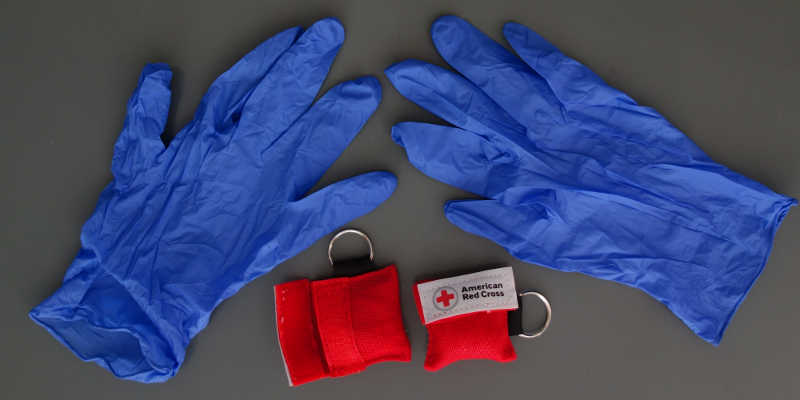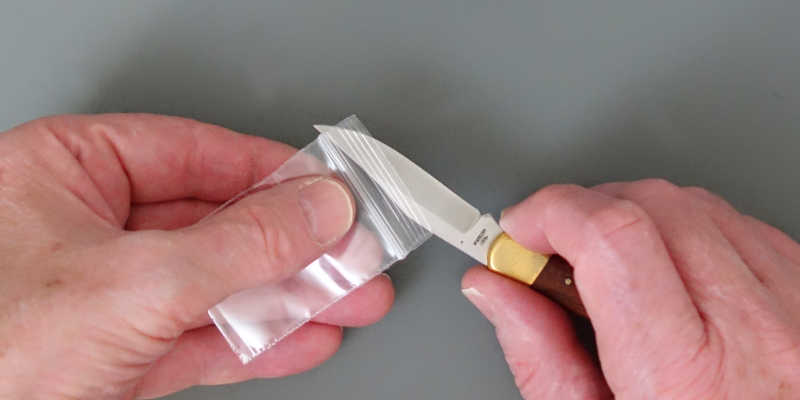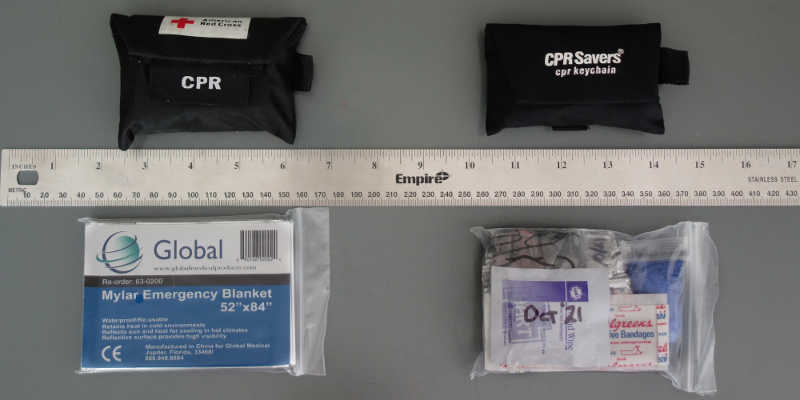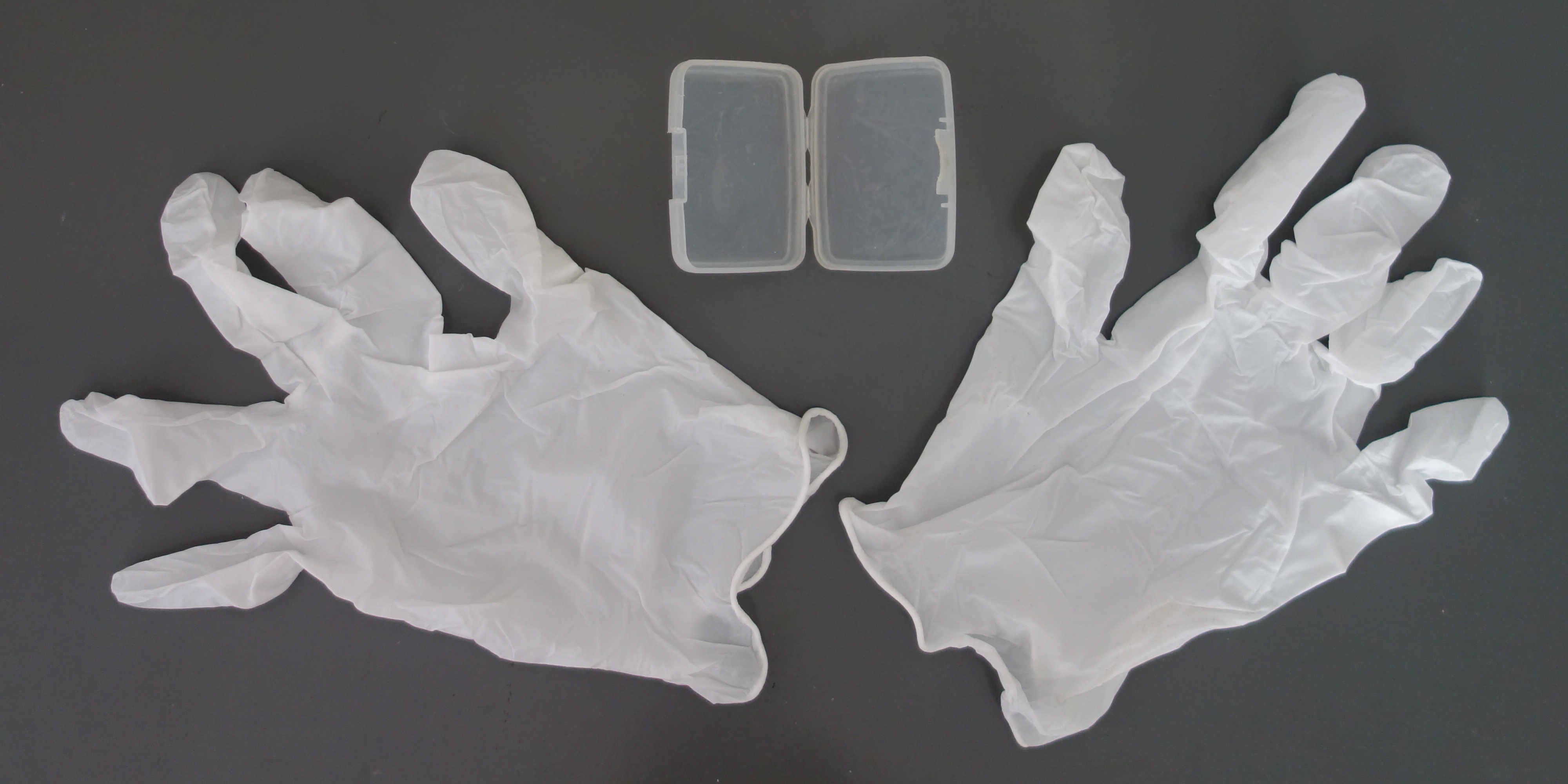My EDC First Aid Kit
This article will only focus on basic first aid items that will fit in a typical, front, top, pants pocket. Comments about guns, knives, watches, and cell phones will be left to others.
Personal Protective Equipment

The primal importance of personal protective equipment has been beat into my head from day one of my EMS training. Thus, it should be no surprise that my first EDC first aid kit was a CPR keychain with a soft pouch containing gloves and a face shield. At the time, kits containing these items were not commonly available. I was fortunate to have found some for sale at my local Red Cross office, and I purchased several.
Although the Red Cross had its heart in the right place, I was somewhat disappointed with my kits. The gloves were too large. And were also latex, which in all fairness, was common in those days. Although latex, if I recall correctly, protected better than and was less expensive than the vinyl alternatives, the material is a problem for anyone with an allergy to it.
The conservationist in me likes latex because it less damaging to the natural environment than synthetic alternatives, but herein lies another problem. One of my Red Cross CPR instructors reported that when he needed his latex gloves following a traffic collision, he discovered that they had rotted and fallen apart.
The pouch that came with the keychain also seemed less than ideal. Although it was sturdy, flexible, and large enough for additional items, I felt that it would be inadequate to keep its contents clean and safe.
At the time, I had a mistaken impression that gloves were intended to protect a patient as much or more than a first aid provider. I was concerned that ones kept in my pocket, even if contained in a pouch, would quickly become dirty and perhaps damaged by abrasion. Moreover, the germophobe in me did not like the idea of putting my mouth on a face shield that had been exposed to large amounts of the dirt and sand that I had sometimes emptied from my pockets. I started searching for a better container.
The first container I thought of using was an empty 35mm film canister. These were common in the day. Although a short trial run convinced me that film canisters were too large, rigid, and poorly shaped for EDC, they worked well as emergency glove storage containers in my truck.
After a while, I found small, semi-clear, plastic containers for sale in a store that specializes in selling household storage items. The containers were about 2” x 1.5” x .5”, and if I remember correctly, they cost about 6 dollars each. This was exorbitant, but at the time they seemed to perfect, so I bought three. One was for EDC; the others were for backup. They were large enough for a single pair of gloves and were comfortable to carry.
I have since discovered that a large pair of nitrile gloves will fit in an empty, face shield-only, keychain pouch. These tiny CPR key chaines are inexpensive when purchased in bulk, comfortable to carry, and easy to find online.
For a long time, a well-protected pair of gloves was my entire, EDC first aid kit. Any CPR would have had to have been hands-only.
My Transition to Ziplock Baggies
After buying additional CPR supplies from online sources, I became the owner of several face shields. Some of these face shield came protected by small plastic baggies, and I realized that baggies were a solution to the cleanliness problem. I had several small baggies that had come with electronic equipment, but they were in bad condition, and I did not know where to find more. Then one day—in what seemed like a flash of brilliance—I realized that I could simply buy some from eBay.
The first baggies I bought were 2” x 3”, 2 mil, which is almost too small. A pair of large nitrile gloves will fit in one very tightly, and the resulting shape is not optimal. I have also been able to fit a face shield into one, and a medical mask into another, but the procedures required substantial manipulation and a refolding of the items. The baggies were priced at a little less than $6.00 for 100.
For the record, I have ordered baggies thrice from eBay, and each time there has been a snafu with the postage. The first time, I obtained a refund; the other times I simply picked up the items from the post office and coughed up the additional postage because I really wanted the baggies. My memory of the earlier purchase of small plastic containers for 6-dollar apiece made it easier to accept.

Emergency events have required my use of EDC gloves twice ( both times for syncopal episodes involving urine), and both times I have had minor challenges opening the baggies. The difficulty lay in rapidly separating the plastic at the top and rapidly removing the gloves. The best way to deal with this is to slice the sides of a baggies above the zip closure to create two tabs and then crinkle the tabs so they will stay separated. When items are needed, the tabs can be easily found, grasped, and ripped apart.
Larger Kits
I have used bagged gloves as my entire kit, but I now typically use the baggies to protect items contained within larger kits. One of these kits consists of items in a large keychain pouch. Another consists of items in a medium keychain pouch. Others consists of bagged items within larger baggies.

The kit in the large pouch is the one I usually carry in the winter. It contains gloves, a face shield, two antiseptic wipes, two small adhesive bandages, four chewable aspirin, about 24” of 1/2” medical tape, a safety pin, and a mylar emergency blanket.
The mylar emergency blanket will fit in the pouch if it is removed from its original baggie and, while still folded, folded in half. The downside is that the blanket increases the bulk of the kit to the borderline of discomfort in medium-fitting pants and makes the kit noticeably uncomfortable in tight-fitting pants.
The kit in the medium pouch is one I carry in the summer or when comfort is an issue. It contains gloves, a face shield, a surgical mask, two antiseptic wipes, two small adhesive bandages, and four chewable aspirin.
The kits in the larger baggies are ones I am testing to try to improve comfort and capacity. A kit similar to the one I carry in the winter can fit into the baggie that a (52” x 84”) mylar blanket is typically sold in. The blanket needs to be removed, folded, and reinserted. The left over-space leaves room for gloves and additional items.
Exactly which additional items to include has required long thought and remains an ongoing process.
The decision to include a face shield was not taken lightly. A problem with face shields is that using them puts the emergency healthcare provider very close to a patient's vomit. I decided to carry one because giving a few rescue breaths might buy enough time to sustain a patient until more advanced care arrives and, depending on the situation, might be worth the risk being sprayed.
The decision to include aspirin in the kits was also not taken lightly. Providing medicine while off-duty can put a provider across the line that separates practicing first aid from practicing medicine. If I were to provide aspirin to someone other than myself, I would do so only after being advised to by a dispatcher or physician, of course, checking for a valid date and aspirin allergy.
The aspirin in my kits came from a dollar store in a 1-dollar bottle. I wrote its expiration date on 3” x3” pieces of aluminum foil that I wrap around four, chewable, 81 mg tablets. I do not yet know if foil will sufficiently protect the tablets from damage. The aspirin expiration date is written on accompanying antiseptic wipes in case the date fades from the foil. The date is also is a reminder that the wipes need to be regularly replaced since they will dry out and that the adhesive bandage packaging needs to be regularly checked for integrity.
At one time, I carried a flattened roll of about 30” of duct tape. This came in handy once, along with a safety pin to construct, a pancho (sort of) from a mylar blanket, but it was very difficult to unroll.
The antiseptic wipes are about 2” x 2.5” when sealed in their individual foil packages and about 8” x 4.5” when unfolded. Having two is good in case one is needed for cleaning hands when soap and water is not available.
What is the Best, EDC First Aid Kit?
It would be good if an EDC first aid kit containing adult, child and infant bag valves masks, a combat tourniquet, scissors, and hemostatic dressings were commonly within .an arm’s reach, but this is simply not practical. Sometimes one has to make do with much less, and sometimes much less might only be a pair of gloves.

If you are in an emergency situation and need a first aid kit, the best first aid kit is the one you have with you.
